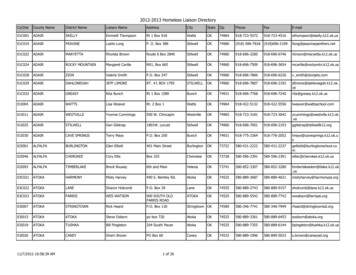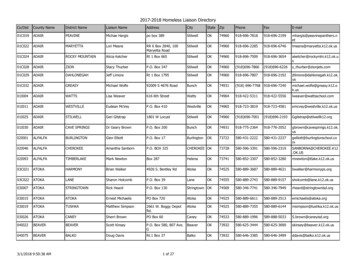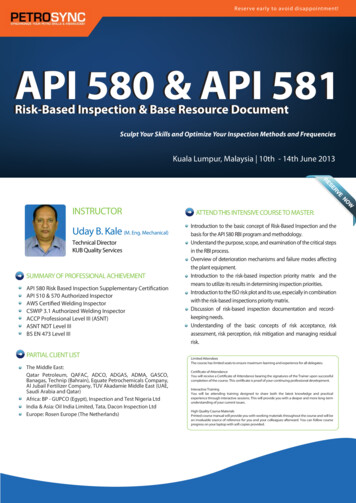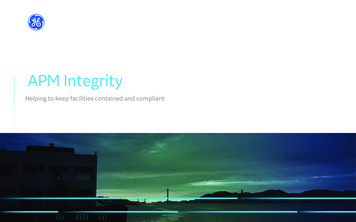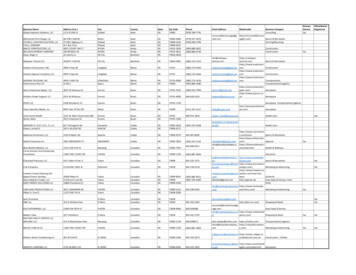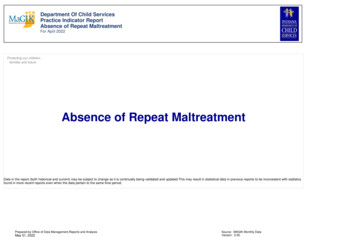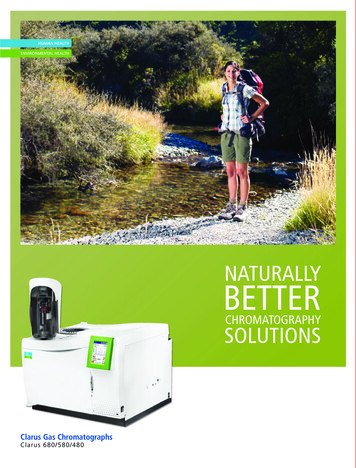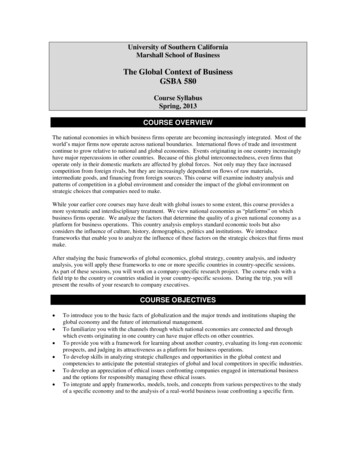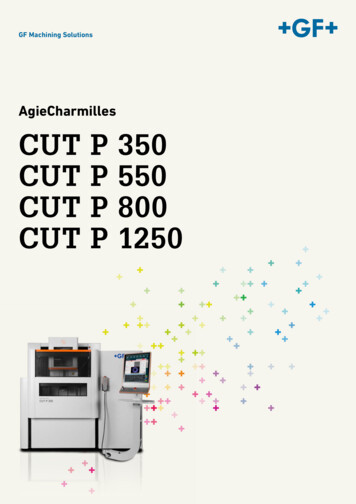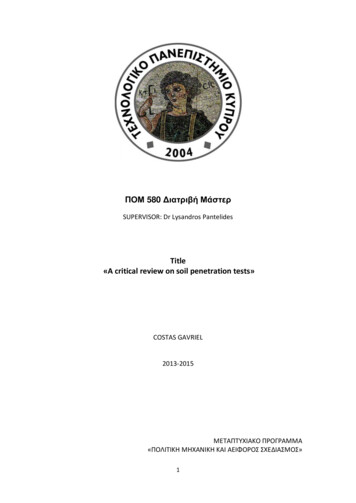
Transcription
ΠΟΜ 580 Διατριβή ΜάστερSUPERVISOR: Dr Lysandros PantelidesTitle«A critical review on soil penetration tests»COSTAS GAVRIEL2013-2015ΜΕΤΑΠΤΥΧΙΑΚΟ ΠΡΟΓΡΑΜΜΑ«ΠΟΛΙΤΙΚΗ ΜΗΧΑΝΙΚΗ ΚΑΙ ΑΕΙΦΟΡΟΣ ΣΧΕΔΙΑΣΜΟΣ»1
AcknowledgementsThough this dissertation is the outcome of individual work, it would never have been completedwithout the help, support and advice of many people.I am in particular indebted to my supervisor Dr Lysandros Pantelides for his academic and practicalguidance in the course of researching and writing this dissertation during the last 4 months.I would like to express my sincere gratitude to my wife, for his valuable practical and psychologicalsupport the past 2 years during my studies.Of course, I wouldn’t be where I am today without the support of my very close people. My Mom,Dad, my two sisters and my nieces. Thank you all for your inexhaustible support.2
AbstractThe purpose of a subsurface exploration program is to investigate those underlying featuressuggested by office research and field reconnaissance so as to confirm, modify, or deny theassumed conditions existing below ground surface. The program of exploration shouldprovide a reasonable idea as to the underlying geologic structure and geomorphic factorsshaping a site. The variety in geological conditions and range of design and constructionproblems make the subject complex. This has led to the development of a considerablenumber of different in situ test techniques. This dissertation offers a critical review on themost commonly used, in civil engineering practice, soil penetration tests, namely, theStandard Penetration Test (SPT) and Cone Penetrometer Test (CPT). Both procedures haveevolved over a period of 100 and 70 years, respectively, and have been adopted as ASTMand EN standards. Each procedure has certain advantages over the other, but both can elicitincorrect data under particular subsurface conditions that are often overlooked, dependingon the experience of field personnel operating or logging the tests.3
Table of ContentsPageCHAPTER 1 INTRODUCTION8CHAPTER 2 SOIL EXPLORATION92.1 General2.2 Soil Exploration2.2.1 Test Pits2.2.2 Boring2.2.3 Planning an Exploration Program2.2.4 Spacing of Borings2.2.5 Depth of Borings2.2.6 Boring LogCHAPTER 3 SOUNDING AND PENETRATION TESTS3.13.23.33.43.516GeneralStandard Penetration Test (SPT)Static Cone Penetration Test (Dutch Cone Test)Dynamic Cone Penetration TestIn-situ Vane Shear TestCHAPTER 4 INTERPRETATION OF CONE PENETRATION TESTS IN SAND AND CLAY.254.14.24.34.4GeneralSoil classification - SandStratigraphy – SandDrained soil4.4.1 Density4.4.2 Drained shear strength of sand4.4.3 Deformation characteristics of sand4.4.3.1 Constrained modulus4.4.3.2 Young's modulus4.4.3.3 Shear modulus4.5 Undrained soil4.5.1 Undrained shear strength of clay4.5.2 Drained shear strength of clay4.6 Deformation characteristics of clay4.6.1 Constrained modulus and compression index4.6.2 Young's modulus4.7 Piezometer cone4.7.1 Pore pressure measurements4.7.2 Soil type and stress history4.7.3 Coefficient of consolidation4.7.4 Groundwater conditions49CHAPTER 5 SPT-CPT CORRELATIONS5.1 General5.2 SPT – CPT Correlations4
5.3 Energy Variations5.4 SPT Hammer Comparison5.5 Other ComparisonsCHAPTER 6 DISCUSSION-CONCLUNSIONS55REFERENCES565
List of figuresFigure123Soil augers (Littlejohn 1970)45678910Cone assembly and friction jacket for static cone penetration test (IS)Cone details for dynamic cone penetration test (IS)Typical set-up for dynamic cone penetration test (IS)Field vane (IS)Arrangement for vane test, from bottom of bore hole (IS)Assumed stress distribution on blades of vaneSoil classification chart for standard electric friction cone (after Douglas and Olsen 1981);1112131420Simplified soil classification chart for standard electric friction cone.Influence of unequal end areasComparison of different relative density relationships.Relationship between bearing capacity number and peak friction angle from large calibrationchamber tests.Proposed correlations between cone bearing and peak friction angle for uncemented, quartzsands.Relationship between cone bearing and drained Young's modulus for normally consolidated,uncemented, quartz sands (based on data from Baldi et a/. 1981).Correlation between dynamic shear modulus number and relative density.Variation of q,/N ratio with mean grain size (after Robertson et al. 1982).Effect of rigidity index and cone angle on the penetration resistance of clay (after Baligh1975).Selection of soil stiffness ratio for clays (adapted from Ladd et nl. 1977).21Summary of existing solutions for pore pressure dissipation (adapted from Gillespie 1981).151617181922232425Set-up for Wash Boring (Littlejohn, 1970)Sample boring logVariation of qc/N Ratio with Mean Grain SizeMeasured Average Energy Ratio for SPT N Values Using Donut Hammer, Tilbury IslandComparison of SPT N Values Using Alternate Donut and Safety Hammer with EnergyCorrected Nc Values)Simplified Soil Classification Chart for Standard Electric Friction Cone. (Adapted fromDouglas and Olsen, 1981)6
List of tablesTable12345Spacing of Borings (Sowers and Sowers, 1970)Depth of Exploration (IS: 1892-1979)Correlation between N, Dr, and φCorrelation between N and quProperties of sand tested in calibration chamber studies6Estimation of constrained modulus, M (after Mitchell and Gardner 1975)7Estimation of compression index, C,, from cu/σvo' ratio (after Schmertmann 1978)7
CHAPTER 1 INTRODUCTIONThe purpose of a subsurface exploration program is to investigate those underlying featuressuggested by office research and field reconnaissance so as to confirm, modify, or deny theassumed conditions existing below ground surface. The program of exploration shouldprovide a reasonable idea as to the underlying geologic structure and geomorphic factorsshaping a site. The variety in geological conditions and range of design and constructionproblems make the subject complex. This has led to the development of a considerablenumber of different in situ test techniques.Mitchell et al. (1978) listed the following four main reasons for a growing interest in the useof in situ testing techniques:(1) Their ability to determine properties of soils, such as sands and offshore depositsthat cannot be easily sampled in the undisturbed state.(2) Their ability to test a larger volume of soil than can conveniently be tested in thelaboratory.(3) Their ability to avoid some of the difficulties of laboratory testing, such as sampledisturbance and the proper simulation of in situ stresses, temperature, and chemicaland biological environments.(4) The increased cost effectiveness of an exploration and testing program using thesein situ methods.Correct selection of the appropriate in situ test technique, however, is governed by thefollowing main factors: geological conditions, project requirements, type of construction, andmethod of analysis intended for design.This dissertation discusses the present status of in situ testing and its application togeotechnical engineering and mainly foundation engineering.8
CHAPTER 2 SOIL EXPLORATION2.1 GeneralA fairly accurate assessment of the characteristics and engineering properties of the soils ata site is essential for proper design and successful construction of any structure at the site.The field and laboratory investigations required to obtain the necessary data for the soils forthis purpose are collectively called soil exploration.The choice of the foundation and its depth, the bearing capacity, settlement analysis andsuch other important aspects depend very much upon the various engineering properties ofthe foundation soils involved.Soil exploration may be needed not only for the design and construction of new structures,but also for deciding upon remedial measures if a structure shows signs of distress afterconstruction. The design and construction of highway and airport pavements will alsodepend upon the characteristics of the soil strata upon which they are to be aligned.The primary objectives of soil exploration are:1. Determination of the nature of the deposits of soil,2. Determination of the depth and thickness of the various soil strata and their extent inthe horizontal direction,3. The location of groundwater and fluctuations in GWT,4. Obtaining soil and rock samples from the various strata,5. The determination of the engineering properties of the soil and rock strata that affect6. the performance of the structure, and7. Determination of the in-situ properties by performing field tests.2.2 Soil ExplorationThe subsoil exploration should enable the engineer to draw the soil profile indicating thesequence of the strata and the properties of the soils involved.In general, the methods available for soil exploration may be classified as follows:1. Direct methods . Test pits, trial pits or trenches2. Semi-direct methods . Borings3. Indirect methods . Soundings or penetration tests and geophysical methodsIn an exploratory program, one or more of these methods may be used to yield the desiredinformation.2.2.1 Test PitsTest pits or trenches are open type or accessible exploratory methods. Soils can beinspected in their natural condition. The necessary soils samples may be obtained bysampling techniques and used for ascertaining strength and other engineering properties byappropriate laboratory tests.Test pits will also be useful for conducting field tests such as the plate-bearing test.Test pits are considered suitable only for small depths—up to 3m; the cost of theseincreases rapidly with depth. For greater depths, especially in pervious soils, lateral supportsor bracing of the excavations will be necessary. Ground water table may also beencountered and may have to be lowered.9
Hence, test pits are usually made only for supplementing other methods or for minorstructures.2.2.2 BoringMaking or drilling bore holes into the ground with a view to obtaining soil or rock samplesfrom specified or known depths is called ‘boring’.The common methods of advancing bore holes are:1. Auger boring2. Auger and shell boring3. Wash boring4. Percussion drilling5. Rotary drilling strataAuger Boring‘Soil auger’ is a device that is useful for advancing a bore hole into the ground. Augers maybe hand-operated or power-driven; the former are used for relatively small depths (less than3 to 5 m), while the latter are used for greater depths. The soil auger is advanced by rotatingit while pressing it into the soil at the same time. It is used primarily in soils in which theborehole can be kept dry and unsupported. As soon as the auger gets filled with soil, it istaken out and the soil sample collected.Two common types of augers, the post hole auger and the helical auger, are shown in figure1.Fig. 1 Soil augersAuger and Shell BoringIf the sides of the hole cannot remain unsupported, the soil is prevented from falling in bymeans of a pipe known as ‘shell’ or ‘casing’. The casing is to be driven first and then theauger; whenever the casing is to be extended, the auger has to be withdrawn, this being animpediment to quick progress of the work.An equipment called a ‘boring rig’ is employed for power-driven augers, which may be usedup to 50 m depth (A hand rig may be sufficient for borings up to 25 m in depth). Casings maybe used for sands or stiff clays. Soft rock or gravel can be broken by chisel bits attached todrill rods. Sand pumps are used in the case of sandy soils.10
Wash BoringWash boring is commonly used for exploration below ground water table for which the augermethod is unsuitable. This method may be used in all kinds of soils except those mixed withgravel and boulders. The set-up for wash boring is shown in Figure 2.Fig. 2 Set-up for Wash BoringInitially, the hole is advanced for a short depth by using an auger. A casing pipe is pushed inand driven with a drop weight. The driving may be with the aid of power. A hollow drill bit isscrewed to a hollow drill rod connected to a rope passing over a pulley and supported by atripod. Water jet under pressure is forced through the rod and the bit into the hole. Thisloosens the soil at the lower end and forces the soil-water suspension upwards along theannular surface between the rod and the side of the hole. This suspension is led to a settlingtank where the soil particles settle while the water overflows into a sump. The watercollected in the sump is used for circulation again.The soil particles collected represent a very disturbed sample and is not very useful for theevaluation of the engineering properties. Wash borings are primarily used for advancing boreholes; whenever a soil sample is required, the chopping bit is to be replaced by a sampler.The change of the rate of progress and change of color of wash water indicate changes insoil strata.Percussion DrillingA heavy drill bit called ‘churn bit’ is suspended from a drill rod or a cable and is driven byrepeated blows. Water is added to facilitate the breaking of stiff soil or rock. The slurry of thepulverized material is bailed out at intervals. The method cannot be used in loose sand andis slow in plastic clay.The formation gets badly disturbed by impact.11
Rotary DrillingThis method is fast in rock formations. A drill bit, fixed to the lower end of a drill rod, isrotated by power while being kept in firm contact with the hole. Drilling fluid or bentoniteslurry is forced under pressure through the drill rod and it comes up bringing the cuttings tothe surface. Even rock cores may be obtained by using suitable diamond drill bits. Thismethod is not used in porous deposits as the consumption of drilling fluid would beprohibitively high.2.2.3 Planning an Exploration ProgramThe planning of an exploration program depends upon the type and importance of thestructure and the nature of the soil strata. The primary purpose the cost involved should beborne in mind while planning a program. The depth, thickness, extent, and composition ofeach of the strata, the depth of the rock, and the depth to the ground water table areimportant items sought to be determined by an exploration program. Further, approximateidea of the strength and compressibility of the strata is necessary to make preliminaryestimates of the safety and expected settlement of the structure.The planning should include a site plan of the area, a layout plan of proposed structures withcolumn locations and expected loads and the location of bore holes and other field tests. Acarefully planned program of boring and sampling is the crux of any exploration job.Resourceful and intelligent personnel trained in the principles of geology and geotechnicalengineering are necessary.The two important aspects of a boring program are ‘spacing of borings’ and ‘depth ofborings’.2.2.4 Spacing of BoringsThe spacing of borings, or the number of borings for a project, is related to the type, size,and weight of the proposed structure, to the extent of variation in soil conditions that permitsafe interpolation between borings, to the funds available, and possibly to the stipulations ofa local building code.It is impossible to determine the spacing of borings before an investigation begins, since itdepends on the uniformity of the soil deposit. Ordinarily a preliminary estimate of the spacingis made. Spacing is decreased if additional data are necessary and is increased if thethickness and depth of the different strata appear about the same in all the borings.The following spacings are recommended in planning an exploration program:Table 1. Spacing of Borings (Sowers and Sowers, 1970)“IS: 1892-1979—Code of Practice for Subsurface Investigation for Foundations” has madethe following recommendations:12
For a compact building site covering an area of about 0.4 hectare, one bore hole or trial pit ineach corner and one in the centre should be adequate. For smaller and less importantbuildings even one bore hole or trial pit in the centre will suffice. For very large areascovering industrial and residential colonies, the geological nature of the terrain will help indeciding the number of bore holes or trial pits. Cone penetration tests may be performed atevery 50 m by dividing the area in a grid pattern and number of bore holes or trial pitsdecided by examining the variation in penetration curves. The cone penetration tests maynot be possible at sites having gravelly or boulderous strata. In such cases geophysicalmethods may be suitable.2.2.5 Depth of BoringsIn order to furnish adequate information for settlement predictions, the borings shouldpenetrate all strata that could consolidate significantly under the load of the structure. Thisnecessarily means that, for important and heavy structures such as bridges and tallbuildings, the borings should extend to rock. For smaller structures, however, the depth ofboring may be estimated from the results of previous investigations in the vicinity of the site,and from geologic evidence.Experience indicates that damaging settlement is unlikely to occur when the additional stressimposed on the soil due to the weight of the structure is less than 10% of the initial stress inthe soil due to self-weight. E.De Beer of Belgium adopted this rule for determining the socalled ‘critical depth of boring’ (Hvorslev, 1949). Based on this, recommended depths ofborings for buildings are about 3.5 m and 6.5 m for single- and two-storey buildings. Fordams and embankments, the depth ranges between half the height to twice the heightdepending upon the foundation soil.According to IS: 1892-1979: “The depth of exploration required depends upon the type of theproposed structure, its total weight, the size, shape and disposition of the loaded area, soilprofile and the physical properties of the soil that constitutes each individual stratum.Normally, it should be one and half times the width of the footing below foundation level. If anumber of loaded areas are in close proximity, the effect of each is additive. In such cases,the whole area may be considered as loaded and exploration should be carried out up toone and half times the lower dimension. In any case, the depth to which seasonal variationsaffect the soil should be regarded as the minimum depth for the exploration of the sites. But,where industrial processes affect the soil characteristics, this depth may be more. Thepresence of fast-growing and water-seeking trees also contributes to the weatheringprocesses.”The depth of exploration at the start of the work may be decided as given in Table 2, whichmay be modified as exploration proceeds, if required.13
Table 2. Depth of Exploration (IS: 1892-1979)2.2.6 Boring LogInformation on subsurface conditions obtained from the boring operation is typicallypresented in the form of a boring record, commonly known as “boring log”. A continuousrecord of the various strata identified at various depths of the boring is presented.Description or classification of the various soil and rock types encountered, and dataregarding ground water level have to be necessarily given in a pictorial manner on the log. A“field” log will consist of this minimum information, while a “lab” log might include test datapresented alongside the boring sample actually tested.Sometimes a subsurface profile indicating the conditions and strata in all borings in series ismade. This provides valuable information regarding the nature of variation or degree ofuniformity of strata at the site. This helps in delineating between “good” and “poor” area. Thestandard practice of interpolating between borings to determine conditions surely involvessome degree of uncertainty.A sample record sheet for a boring is shown in Fig. 3. A site plan showing the disposition ofthe borings should be attached to the records.14
Fig. 3. Sample boring log15
CHAPTER 3 SOUNDING AND PENETRATION TESTS3.1 GeneralSubsurface soundings are used for exploring soil strata of an erratic nature. They are usefulto determine the presence of any soft pockets between drill holes and also to determine thedensity index of cohesionless soils and the consistency of cohesive soils at various desireddepths from the ground surface.Methods of sounding normally consist of driving or pushing a standard sampling tube or acone. The devices involved are also termed ‘penetrometers’, since they are made topenetrate the subsoil with a view to measuring the resistance to penetration of the soil strata,and thereby try to identify the soil and some of its engineering characteristics. The necessaryfield tests are also called ’penetration tests’.If a sampling tube is used to penetrate the soil, the test is referred to as the StandardPenetration Test (SPT, for brevity). If a cone is used to penetrate the soil, the test is called a‘Cone penetration test’. Static and dynamic cone penetration tests are used depending uponthe mode of penetration—static or dynamic.A field test called ‘Vane Test’ is used to determine the shearing strength of the soil located ata depth below the ground.3.2 Standard Penetration Test (SPT)The Standard Penetration Test (SPT) is widely used to determine the parameters of the soilin-situ. The test is especially suited for cohesionless soils as a correlation has beenestablished between the SPT value and the angle of internal friction of the soil.The test consists of driving a split-spoon sampler (Fig. 18.6) into the soil through a bore hole55 to 150 mm in diameter at the desired depth. A hammer of 640 N (65 kg) weight with afree fall of 750 mm is used to drive the sampler. The number of blows for a penetration of300 mm is designated as the “Standard Penetration Value” or “Number” N. The test isusually performed in three stages. The blow count is found for every 150 mm penetration. Iffull penetration is obtained, the blows for the first 150 mm are ignored as those required forthe seating drive. The number of blows required for the next 300 mm of penetration isrecorded as the SPT value. The test procedure is standardised by ISI and set out in “IS:2131-1986—Standard Penetration Test”.Usually SPT is conducted at every 2 m depth or at the change of stratum. If refusal isnoticed at any stage, it should be recorded.In the case of fine sand or silt below water-table, apparently high values may be notedfor N. In such cases, the following correction is recommended (Terzaghi and Peck, 1948):Where N′ observed SPT value,N corrected SPT value.For SPT made at shallow levels, the values are usually too low. At a greater depth, the samesoil, at the same density index, would give higher penetration resistance.The effect of the overburden pressure on SPT value may be approximated by the equation:Where N′ observed SPT value,N corrected SPT value, and16
σ effective overburden pressure in KN/m2, not exceeding 280 KN/m2. This impliesthat no correction is required if the effective overburden pressure is 280 kN/m2.Terzaghi and Peck also give the following correlation between SPT value, Dr, and φ:Table 3. Correlation between N, Dr, and φFor clays the following data are given:Table 4. Correlation between N and quThe correlation for clays is rather unreliable. Hence, vane shear test is recommended formore reliable information.3.3 Static Cone Penetration Test (Dutch Cone Test)The Static cone penetration test, which is also known as Dutch Cone test, has beenstandardized by the ISI and given in “IS: 4968 (Part-III)-1976—Method for subsurfacesounding for soils—Part III Static cone penetration test”.Among the field sounding tests the static cone tests in a valuable method of recordingvariation in the in-situ penetration resistance of soils, in cases where the in-situ density isdisturbed by boring operations, thus making the standard penetration test unreliableespecially under water. The results of the test are also useful in determining the bearingcapacity of the soil at various depths below the ground level. In addition to bearing capacityvalues, it is also possible to determine by this test the skin friction values used for thedetermination of the required lengths of piles in a given situation. The static cone test is mostsuccessful in soft or loose soils like silty sands, loose sands, layered deposits of sands, siltsand clays as well as in clayey deposits. In areas where some information regarding the17
foundation strata is already available, the use of test piles and loading tests thereof can beavoided by conducting static cone penetration tests.Experience indicates that a complete static cone penetration test up to depths of 15 to 20 mcan be completed in a day with manual operations of the equipment, making it one of theinexpensive and fast methods of sounding available for investigation.The equipment consists of a steel cone, a friction jacket, sounding rod, mantle tube, a drivingmechanism and measuring equipment.The steel cone shall be of steel with tip hardened. It shall have an apex angle of 60 15′and overall base diameter of 35.7 mm giving a cross-sectional area of 10 cm2. The frictionjacket shall be of high carbon steel. These are shown in Fig. 4.Fig 4. Cone assembly and friction jacket for static cone penetration test (IS)The sounding rod is a steel rod of 15 mm diameter which can be extended with additionalrods of 1 m each in length. The mantle tube is a steel tube meant for guiding the soundingrod which goes through it. It should be of one meter in length with flush coupling.The driving mechanism should have a capacity of 20 to 30 KN for manually operatedequipment and 100 KN for the mechanically operated equipment. The mechanismessentially consists of a rack and pinion arrangement operated by a winch. The reaction forthe thrust may be obtained by suitable devices capable of taking loads greater than thecapacity of the equipment.18
The hand operated winch may be provided with handles on both sides of the frame tofacilitate driving by four persons for loads greater than 20 kN. For the engine drivenequipment the rate of travel should be such that the penetration obtained in the soil duringthe test is 10 to 15 mm/s.Hydraulic pressure gauges should be used for indicating the pressure developed.Alternatively, a proving ring may also be used to record the cone resistance. Suitablecapacities should be fixed for the gauges.Basically, the test procedure for determining the static cone and frictional resistancesconsists of pushing the cone alone through the soil strata to be tested, then the cone and thefriction jacket, and finally the entire assembly in sequence and noting the respectiveresistance in the first two cases. The process is repeated at predetermined intervals. Afterreaching the deepest point of investigation the entire assembly should be extracted out ofthe soil.The results of the test shall be presented graphically, in two graphs, one showing the coneresistance in kN/m2 with depth in meters and the other showing the friction resistance inkN/m2 with depth in meters, together with a bore hole log.The cone resistance shall be corrected for the dead weight of the cone and sounding rods inuse. The combined cone and friction resistance shall be corrected for the dead weight of thecone, friction jacket and sounding rods. These values shall also be corrected for the ratio ofthe ram area to the base area of the cone.The test is unsuitable for gravelly soils and for soils with standard penetration value Ngreater than 50. Also, in dense sands the anchorage becomes too cumbersome andexpensive and for such cases dynamic cone penetration tests may be carried out.3.4 Dynamic Cone Penetration TestThe dynamic cone penetration test is standardised by the ISI and given in “IS: 4968 (Part I)1976—Method for Subsurface Sounding for Soils—Part I Dynamic method using 50 mmcone without bentonite slurry”.Fig. 5. Cone details for dynamic cone penetration test (IS)19
The equipment consists of a cone, driving rods, driving head, hoisting equipment and ahammer.The cone with threads (recoverable) shall be of steel with tip hardened. The cone withoutthreads (expendable) may be of mild steel. For the cone without threads, a cone adoptershall be provided. These are shown in Fig. 5.The driving rods should be A rods of suitable length with threads for joining A rod coupling ateither end. The rods should be marked at every 100 mm.The driving head shall be of mild steel with threads at either end for a rod coupling. It shallhave a diameter of 100 mm and a length of 100 to 150 mm.Any suitable hoisting equipment such as a tripod may be used. A typical set-up using atripod is shown in Fig. 6.Fig. 6. Typical set-up for dynamic cone penetration test (IS)The hammer used for driving the cone shall be of mild steel or cast-iron with a base of mildsteel. It shall be 250 mm high and of suitable diameter. The weight of the hammer shall be640 N (65 kg).The cone shall be driven into the soil by allowing the hammer to fall freely through 750 mmeach time. The number of blows for every 100 mm penetration of the cone shall be recorded.The process shall be repeated till the cone is driven to the required depth. To save theequipment from damage, driving may be stopped when the number of blows exceeds 35 for100 mm penetration.20
When the depth of investigation is more than 6 m, bentonite slurry may be used foreliminating the friction on the driving rods. The cone used in this case is of 62.5 mm size andthe details of the dynamic method using bentonite slurry, as standardized by the ISI, areavailable in “IS: 4968 (Part-II)-1976—Method for subsurface Sounding for Soils—Part IIDynamic method using 62.5 mm cone and bentonite slurry”.Dynamic Cone Penetration test is a simple device for probing the soil strata and it has anadvantage over the standard penetration test in that making of a bore hole is avoided.Moreover, the data obtained by cone test provides a continuous record of soil resistance.Efforts are being made to correlate the cone resistance with the SPT value for dif
6 List of figures Figure 1 Soil augers (Littlejohn 1970) 2 Set-up for Wash Boring (Littlejohn, 1970) 3 Sample boring log 4 Cone assembly and friction jacket for static cone penetration test (IS) 5 Cone details for dynamic cone penetration test (IS) 6 Typical set-up for dynamic cone penetration test (IS) 7 Field vane (IS) 8 Arrangement for vane test, from bottom of bore hole (IS)
